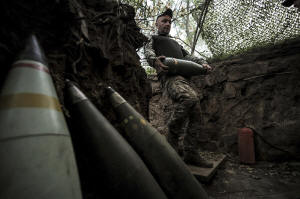Russia ramps up offensives on 2 fronts in Ukraine as both sides seek an
advantage before the fall
[July 02, 2025]
By SAMYA KULLAB and YEHOR KONOVALOV
KYIV, Ukraine (AP) — An emboldened Russia has ramped up military
offensives on two fronts in Ukraine, scattering Kyiv’s precious reserve
troops and threatening to expand the fighting to a new Ukrainian region
as each side seeks an advantage before the fighting season wanes in the
autumn.
Moscow aims to maximize its territorial gains before seriously
considering a full ceasefire, analysts and military commanders said.
Ukraine wants to slow the Russian advance for as long as possible and
extract heavy losses.
Kremlin forces are steadily gaining ground in the strategic eastern
logistics hub of Pokrovsk, the capture of which would hand them a major
battlefield victory and bring them closer to acquiring the entire
Donetsk region. The fighting there has also brought combat to the border
of the neighboring Dnipropetrovsk region for the first time.
In an effort to prevent Moscow from bolstering those positions in the
east, Ukrainian forces are trying to pin down some of Russia’s best and
most battle-hardened troops hundreds of kilometers away, in the
northeast Sumy region.
“The best-case scenario for Ukraine," said Russian-British military
historian Sergey Radchenko, "is that they’re able to stall or stop the
Russian advance" in the Ukrainian industrial heartland known as Donbas,
which includes the Donetsk and Luhansk regions. Then Ukraine could "use
that as the basis for a ceasefire agreement.”

“There’s a better chance for Russia to come to some kind of terms with
Ukraine" in the fall when the Russians "see the extent of their
offensive,” Radchenko added.
While the battles rage, Ukrainian President Volodymyr Zelenskyy is
waiting to learn whether the Trump administration will support tougher
sanctions against Russia and back a European idea to establish a
“reassurance force” to deter Moscow.
A setback came with the U.S. decision Tuesday to halt some weapons
shipments to Ukraine out of concern over America's own depleted
stockpiles.
Ukraine faces relentless assaults in Sumy
In the Sumy region, Ukrainian forces face a constant barrage of aerial
glide bombs, drones and relentless assaults by small groups of Russian
infantrymen. They endure the attacks to prevent Russian forces from
being moved to other battlegrounds in the eastern Donetsk region.
Ukrainian forces intensified their own attacks in Sumy in April and even
conducted a small offensive into Russia's neighboring Kursk region to
prevent up to 60,000 battle-hardened Russian forces from being moved to
reinforce positions in the Donetsk, Zaporizhzhia and Kherson regions,
Ukraine’s top army commander, Gen. Oleksandr Syrskyi, said last week.
If those troops had been moved, they could have increased the tempo of
Russian attacks across the front line and stretched Ukrainian forces
thin.
The strategy did not come without criticism. Commanders who were ordered
to execute it complained that it resulted in unnecessary loss of life.
Russian forces have penetrated up to 7 kilometers (4 miles) into the
northern Sumy region from different directions along the border.
Ukrainian forces are determined to keep them there to avoid freeing up
Russian forces to fight in the east. So far they have succeeded, locking
up to 10,000 Russian troops in the Glushkovsky district of the Kursk
region alone, where Ukraine maintains a small presence after being
mostly forced out by Russian and North Korean troops earlier in the
year.

Russia seeks maximum gains in Donetsk
The war's largest battle is being waged in Donetsk as Russia inches
toward its stated goal of capturing all of the Donetsk and Luhansk
regions.
Unable to tackle the strategically significant logistical hub of
Pokrovsk directly, Russian forces are attempting to encircle the city, a
maneuver that requires encroaching on the borders of the Dnipropetrovsk
region. Bringing the war to a sixth Ukrainian region would be
detrimental for Ukrainian morale and give Russia more leverage in
negotiations if its forces manage to carve out a foothold there.
[to top of second column]
|

In this photo provided by Ukraine's 24th Mechanized Brigade
press service, a serviceman prepares to fire a howitzer toward
Russian army positions near Chasiv Yar, Donetsk region, Ukraine,
June 14, 2025. (Oleg Petrasiuk/Ukraine's 24th Mechanized Brigade via
AP, File)

Sabotage groups have crossed the border, only to be eliminated by
Ukrainian forces.
But in time, commanders fear that Russia will advance as Ukraine
continues to grapple with severe shortages.
Lack of soldiers and supplies across the 1,200-kilometer (745-mile)
front line mean that Ukrainian forces must concentrate on holding
their positions and conserving resources rather than advancing, said
Oleksii Makhrinskyi, deputy commander of the Da Vinci Wolves
battalion.
Commanders describe battles so intense under drone-saturated skies
that rotating forces in and out of position has become a deadly
operation. Ukrainian forces remain in combat positions for several
weeks at a time or more, relying on supplies carried in by drones.
The Russians' goal "is just to enter Dnipropetrovsk region, to have
a good position politically if the presidents negotiate peace,” said
Andrii Nazerenko, a commander of the 72nd Brigade, a drone unit in
eastern Ukraine, referring to potential talks between Zelenskyy and
Russian President Vladimir Putin.
“They’re really close to getting what they want,” he said.
All eyes on Trump’s next move
Zelenskyy hopes U.S. President Donald Trump will move away from his
administration's past ambivalence toward Ukraine and signal his
intention to continue American support, a move that could also alter
Moscow’s calculations.
The two presidents met last week on the sidelines of a NATO summit
and discussed a possible weapons package, including Patriot missile
systems that Ukraine intends to purchase with European support.
The U.S. Defense Department announcement now calls that into
question although it did not specify which weapons were being held
back when it disclosed the Pentagon review of American weapons
stockpiles Tuesday. The halt of any weapons from the U.S. would be a
blow to Ukraine as it struggles to confront Russia’s daily aerial
barrages.

Zelenskyy also hopes Trump will punish Russia by imposing harsher
sanctions on its energy and banking sectors, which bankroll the
Kremlin’s war effort.
Europe and the U.S. have imposed successive sanctions on Russia
since the full-scale invasion in 2022, but Zelenskyy says those
measures have not been enough to pierce Moscow’s war machine. He has
proposed a $30 per barrel price cap on Russian oil.
EU sanctions envoy David O’Sullivan said Europe needs to maintain
the sanctions pressure while also “holding out the prospect that if
Russia behaves correctly, we could have some kind of ceasefire and
some kind of sense of negotiation, but for the moment Russia doesn’t
seem to want that.”
Kyiv’s closest European allies are also awaiting a sign from Trump
that he will support a plan to deploy foreign troops in Ukraine to
guard against future Russian aggression after a ceasefire agreement.
That is likely the best security guarantee Ukraine can hope for in
lieu of NATO membership.
Meanwhile on the battlefield, Russian forces appear increasingly
confident.
Nazerenko noticed a shift in the morale of advancing Russian
infantrymen in recent months. Instead of running away while being
assailed by Ukrainian drones, they keep pushing forward.
Nazerenko could not help but ask a Russian prisoner: “You know you
will die. Why go?”
Because, the Russian soldier replied: “We will win.”
___
Associated Press journalist Volodymyr Yurchuk contributed to this
report.
All contents © copyright 2025 Associated Press. All rights reserved |